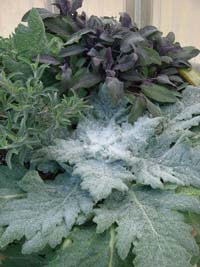Quick Digs: Overwintering Salvias in Containers Outdoors

In chilly climates, such as USDA Cold Hardiness Zones with winter temperatures lower than those of Zone 8, it is difficult for potted plants to survive outdoors when the mercury dips.
Soil in containers freezes harder and thaws more rapidly than the ground. So plants in containers are subjected to bigger changes in conditions on a winter patio or entryway.
This is the third article in our Quick Digs series on preparation for winter in the Salvia garden, which began here. The second post concerns winter mulching. Each Quick Digs series selects a central issue about gardening and provides a series of brief articles suggesting ways to deal with the issue. This post begins with some basics for improving chances of survival when overwintering sages in containers.
Basic Rules for Winter Survival in Containers
First, to improve the odds for container plants that must stay outdoors, it's best to select species that are winter hardy to temperatures far colder than those suitable for in-ground planting.
The general rule is to choose plants that are hardy to two USDA Cold Hardiness Zones lower than your local zone. So if you live in Zone 7, you could more easily winter over containerized plants that are acclimated to Zone 5.
Second, you'll risk less exposure of roots to harsh winter air if you plant in pots made of plastic, fiberglass and composite materials, including poly-resin containers. Pots made of clay, porcelain or glazed materials break more easily from repeated freezing and thawing.
Third, the rule is to experiment. Here are some techniques suggested by home gardeners for protecting container plantings outside:
- Beneficial placement next to houses
- Grouping potted plants in semi-protected settings
- Pot plunging -- placing a containerized sage in the ground -- and
- Removing sages from pots and planting them in the garden.
Brief, Beneficial Placement
If it becomes obvious that first frost is on its way, but your outdoor potted plants aren't protected, a good short-term choice is to place them under eaves and close to the walls of your house. Then cover them with a tarp or tablecloth. But you'll need to scurry in ensuing days to provide better shelter.
Protective Groupings
In warmer zones where it occasionally snows, some gardeners group potted perennials together under benches and picnic tables. It's a good idea to rest the pots on straw or leaves and then to surround them with more of this mulch. Place the most vulnerable plants in the center of the group.
Then cover the table with a clear tarp or shower curtain held in place by bricks or rocks. Aside from precipitation, this protects the plants against rough winds. On days when temperatures rise, you can open the cover and water the plants.
Pots can also be grouped on top of a raised bed and surrounded with organic mulch, then covered with a tarp. A third idea is to create a cold frame of hay bales one to two stacks high, group containers within this enclosure and cover it with plastic. If it is warm enough during the day, peel back part of the cover for airing.
Pot Plunging in Garden Soil
One long-time technique for overwintering container plants is called pot plunging. You can even read about the technique in volume two of the American Magazine of Useful and Entertaining Knowledge, which was published in 1836 by novelist Nathaniel Hawthorne and his sister, Elizabeth Manning Hawthorne.
The name of this technique sounds a bit daring like bungee jumping, but simply involves planting your sages -- container and all -- in the ground with the lip of the container just above soil line. Then you apply a thick layer of leaves or other mulch.
To further insulate the pot and protect it from staining, you can wrap its sides in bubble wrap before planting. But leave the bottom unwrapped for drainage.
Out of the Pot and Into the Ground
Finally, you can chuck the containers altogether, at least for the winter. Simply dig a hole in the garden, remove your sages from their containers and plant them in the ground. In the spring, you can dig them up and return them to their container homes. Of course, this works best if your plants are appropriate for the local zone or a colder one.
Ready to Answer Questions
The fourth article in this series explores wintering over Salvias indoors. In addition to offering lots of information in our Everything Salvias Blog, we're always here and ready to answer your questions. So if you need some reassurance before experimenting with overwintering container sages, feel free to contact us. We'll be glad to listen, share ideas, commiserate about failed overwintering experiments, and celebrate your successes.

Comments
There are no comments yet.